
San Gimignano is a small walled medieval hill town in the province of Siena, Tuscany, north-central Italy. Known as the Town of Fine Towers, San Gimignano is famous for its medieval architecture, unique in the preservation of about a dozen of its tower houses, which, with its hilltop setting and encircling walls, form "an unforgettable skyline". Within the walls, the well-preserved buildings include notable examples of both Romanesque and Gothic architecture, with outstanding examples of secular buildings as well as churches. The Palazzo Comunale, the Collegiate Church and Church of Sant' Agostino contain frescos, including cycles dating from the 14th and 15th centuries. The "Historic Centre of San Gimignano" is a UNESCO World Heritage Site. The town also is known for saffron, the Golden Ham, pecorino cheese and its white wine, Vernaccia di San Gimignano, produced from the ancient variety of Vernaccia grape which is grown on the sandstone hillsides of the area.

Volterra is a walled mountaintop town in the Tuscany region of Italy. Its history dates from before the 8th century BC and it has substantial structures from the Etruscan, Roman, and Medieval periods.
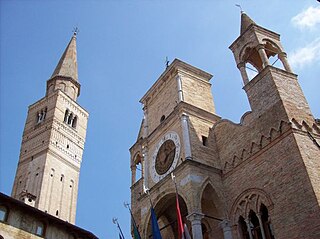
Pordenone is a city and comune (municipality) in the Italian region of Friuli-Venezia Giulia, the capital of the Regional decentralization entity of Pordenone.

The province of Chieti is a province in the Abruzzo region of Italy. Its provincial capital is the city Chieti, which has a population of 50,770 inhabitants. The province has a total population of 387,649 inhabitants as of 2017 and spans an area of 2,599.58 square kilometres (1,003.70 sq mi). The province contains 104 comuni. Its provincial president is Mario Pupillo.

The Palazzo Pubblico is a palace in Siena, Tuscany, central Italy. Construction began in 1297 to serve as the seat of the Republic of Siena's government, which consisted of the Podestà and Council of Nine, the elected officials who performed executive functions. The palace is of medieval and Gothic architecture, and the interior is lined with frescoes--most importantly, the collection known as The Allegory of Good and Bad Government by Ambrogio Lorenzetti.
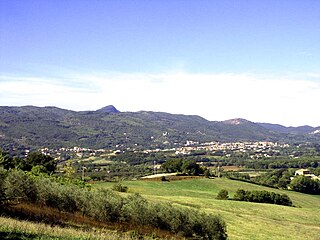
The province of Caserta is a province in the Campania region of Italy. Its capital is the city of Caserta, situated about 36 kilometres (22 mi) by road north of Naples. The province has an area of 2,651.35 square kilometres (1,023.69 sq mi), and had a total population of 924,414 in 2016. The Palace of Caserta is located near to the city, a former royal residence which was constructed for the Bourbon kings of Naples. It was the largest palace and one of the largest buildings erected in Europe during the 18th century. In 1997, the palace was designated a UNESCO World Heritage Site.

The Torre del Mangia is a tower in Siena, in the Tuscany region of Italy. Built in 1338-1348, it is located in the Piazza del Campo, Siena's main square, next to the Palazzo Pubblico. When built it was one of the tallest secular towers in medieval Italy. At 102 m it is now Italy's second tallest after Cremona Cathedral's Torrazzo, the Asinelli tower in Bologna at 97 m being third.

Montepulciano is a medieval and Renaissance hill town and comune in the Italian province of Siena in southern Tuscany. It sits high on a 605-metre (1,985 ft) limestone ridge, 13 kilometres (8 mi) east of Pienza, 70 kilometres (43 mi) southeast of Siena, 124 kilometres (77 mi) southeast of Florence, and 186 kilometres (116 mi) north of Rome by car.

Piazza dei Cavalieri is a landmark in Pisa, Italy, and the second main square of the city. This square was the political centre in medieval Pisa. After the middle of 16th century the square became the headquarters of the Order of the Knights of St. Stephen. Now it is a centre of education, being the main house of the Scuola Normale di Pisa, a higher learning institution part of the University.

Pals is a medieval town in Catalonia, northern Spain, a few kilometres from the sea in the heart of the Bay of Emporda on the Costa Brava. It lies on the C31 Palafrugell–L'Estartit road.
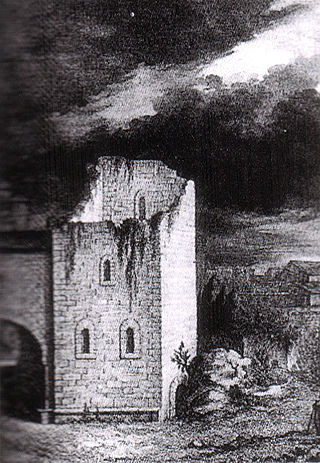
The Torre dei Gualandi is a former tower in Pisa, central Italy, now included in the Palazzo dell'Orologio.
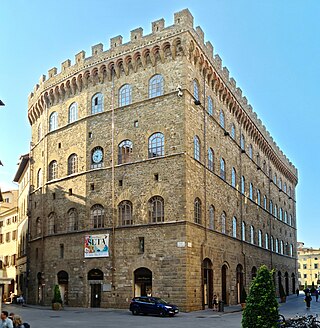
Palazzo Spini Ferroni is a large Gothic palace located along Via de' Tornabuoni at the corner of Piazza Santa Trinita, in central Florence, Tuscany, Italy. It stands across from the church of Santa Trinita.

The Vasari Corridor is an elevated enclosed passageway in Florence, central Italy, connecting the Palazzo Vecchio with the Palazzo Pitti. Beginning on the south side of the Palazzo Vecchio, it joins the Uffizi Gallery and leaves on its south side, crossing the Lungarno dei Archibusieri, then following the north bank of the River Arno until it crosses the river at Ponte Vecchio. At the time of construction, the corridor had to be built around the Torre dei Mannelli, using brackets, because the tower's owners refused to alter it. The corridor conceals part of the façade of the Church of Santa Felicità. It then snakes its way over rows of houses in the Oltrarno district, becoming narrower, to finally join the Palazzo Pitti. The corridor's full length is approximately one kilometre.

Piazza del Duomo is located in the heart of the historic center of Florence. It is one of the most visited places in Europe and the world and in Florence, the most visited area of the city. The square contains Florence Cathedral with the Cupola del Brunelleschi, the Giotto's Campanile, the Florence Baptistery, the Loggia del Bigallo, the Opera del Duomo Museum, and the Arcivescovile and Canonici's palace. The west zone of this square is called Piazza San Giovanni.

Piazza della Cisterna is a piazza in San Gimignano, Italy. It has a triangular shape with a slight natural slope and is connected to the nearby Piazza del Duomo by an open passage. The pavement is brick and the piazza is surrounded by houses and medieval towers. There are presently 5 towers onto the square or very near it and the bases of other five are visible on the facade of the various palaces, plus one, the Ridolfi tower, which is no longer in existence having collapsed in 1646 onto the family palace, which divided the square in two alongside the short axis, thus making this relatively small area a concentrate of medieval architecture. In the south-west corner, the piazza meets the Arc of Becci,, an ancient city gate. The arc is flanked by the massive rectangular towers of Becci on the left and Cugnanesi on the right.
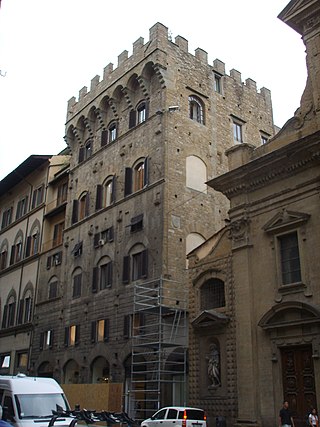
The Torre dei Gianfigliazzi is a Romanesque-style medieval tower-residence located on Via de' Tornabuoni #1 in central Florence, region of Tuscany, Italy. It can be seen rising adjacent to the left of the church of Santa Trinita. It now hosts a hotel.

Piazza d'Aracoeli is a square of Rome (Italy), placed at the base of the Capitoline Hill, in the Rione X Campitelli.

Palazzo Sansedoni is a Gothic style urban palace and tower, whose concave facade is situated facing the Palazzo Pubblico across the Piazza del Campo in the political center of the city of Siena, region of Tuscany, Italy.

The Palazzo Bartolini-Torrigiani is a palace located between Via Porta Rossa and Via delle Terme, in the city block just west of Piazza Santa Trinita that includes the Palazzo Bartolini Salimbeni, in the center of the city of Florence, region of Tuscany, Italy. This portion of the block includes the medieval Torre dei Monaldi, also known as della Rognosa, rising along Via Porta Rossa.

Devil's Tower is a tower located in the north of San Gimignano, Tuscany, Italy, which flanks the Palazzo Cortesi. It is named as Devil's Tower according a legend in which the owner returned after a long journey and said it had grown taller because of an devil. It sets the Torture Instruments Museums, which provides scientific presentation of this subject matter.




















